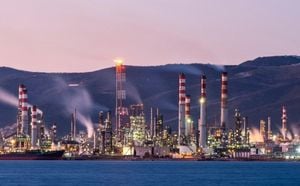South Asia is currently grappling with a severe air pollution crisis, drawing urgent responses from various governments as the smog covers cities and poses significant health risks to millions. With Lahore, Pakistan, recently topping the charts as the world’s most polluted city, the crisis has compelled authorities to implement drastic emergency measures.
Punjab, the province hardest hit by this choking smog, has declared a health emergency. This decision came after worsening air quality figures showed the Air Quality Index (AQI) levels skyrocketing to 637 on some days, significantly higher than the World Health Organization's recommended guidelines. Compared to other cities such as Sydney, where the AQI was just 13 and 18 on the same day, Lahore's pollution levels paint a stark picture.
To combat the soaring pollution levels, the local government has imposed several restrictions, including bans on construction projects, the closure of schools, and the moving of university classes to online formats. Senior Minister Marriyum Aurangzeb announced, "A complete lockdown will be enforced on Friday, Saturday, and Sunday next week if the situation does not improve by Wednesday." The urgency of the situation is underscored by reports indicating over 70,000 patients with respiratory issues were treated daily due to the high levels of pollution.
This year’s pollution crisis has been fueled by several factors, including seasonal weather patterns trapping dust and emissions and the massive smoke from illegal stubble burning. The winter months, particularly, see these conditions worsen, as cooler air settles and limits the dispersion of trapped pollutants. Neighboring India also plays a role; Punjab officials have complained about the influx of toxic air flowing from the Indian side.
Children are particularly vulnerable during this crisis, which UNICEF has identified as posing grave threats to over 11 million kids under the age of five. Their delicate respiratory systems make them more at risk from pollutants, leading to long-term health complications.
Meanwhile, cities across the border are also responding to their own pollution crises. New Delhi, often battling for the title of the world's most polluted capital city, has implemented its own set of emergency measures including halting non-essential construction and shifting classes for younger children to online formats. On certain days, the capital reported AQI levels exceeding WHO's safe limit by more than 50 times.
Recent measures taken by the Indian government include the enforcement of the Graded Action Response Plan (GRAP), which targets severe pollution levels with strict bans on construction, and restrictions on BS-III petrol and BS-IV diesel vehicles. These steps aim to tackle the source of pollution from both vehicular emissions—responsible for approximately 51.5% of Delhi's air pollution—and other industrial activities.
The air pollution crisis poses severe threats not just to physical health but also impacts mental well-being. Doctors have raised alarms over increasing gastrointestinal and metabolic conditions attributed to the harmful effects of polluted air. Dr. Sukrit Singh Sethi, from Narayana Hospital, warns about the cumulative impact of inhaling toxic particles leading to systemic inflammation and oxidative stress, which disrupts gut health and overall bodily functions.
Streamlining public transport and promoting off-peak travel has become more important than ever. Authorities are incentivizing the use of public transportation to limit traffic emissions during peak times. For those still needing to travel, experts advocate wearing protective masks, especially during high pollution periods, as well as limiting outdoor activities during peak pollution hours, like early mornings and late afternoons.
The measures taken across South Asian cities reflect growing acknowledgment of the health hazards associated with air pollution. Residents are finding themselves needing to navigate not just hazardous smog but also school closures and reprogrammed work schedules as authorities scramble to address short-term and long-term impacts of this pressing crisis. Local governments are under immense pressure to find lasting solutions to prevent recurring health emergencies caused by polluting practices.
Through these tumultuous times, communities are uniting and outside agencies are being called upon to provide assistance as well as solutions to combat rampant pollution. Experts remain encouraged by the collaborative efforts of various local, national, and international stakeholders, but stress the need for sustained efforts to bring lasting change to air quality levels across South Asia.
Only proactive and comprehensive plans can address the systemic issues at the heart of air pollution. Until then, residents of South Asia will continue to face the brunt of air pollution, affecting health, livelihoods, and the overall quality of life.



